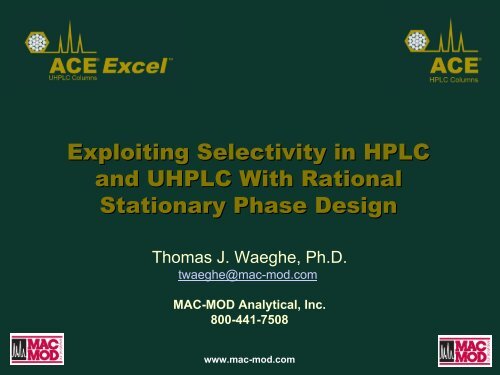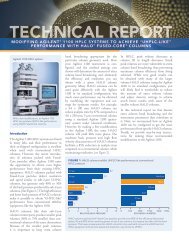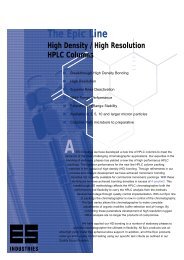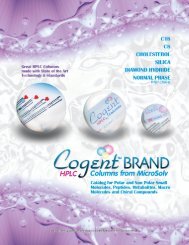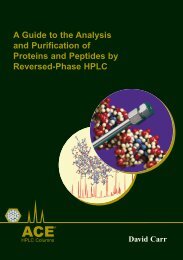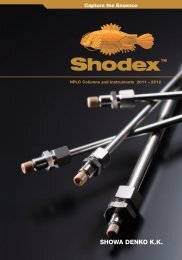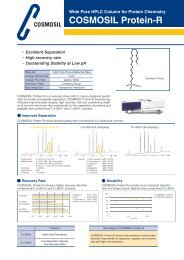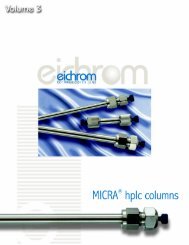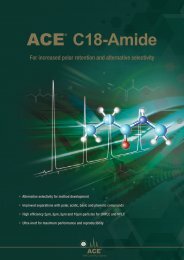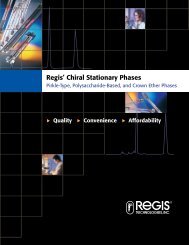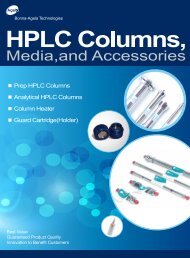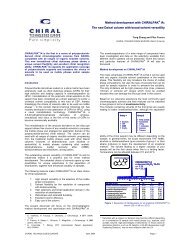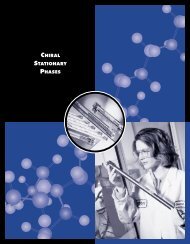ACE C18-AR and C18-PFP - Hplc.eu
ACE C18-AR and C18-PFP - Hplc.eu
ACE C18-AR and C18-PFP - Hplc.eu
Create successful ePaper yourself
Turn your PDF publications into a flip-book with our unique Google optimized e-Paper software.
Exploiting Selectivity in HPLC<strong>and</strong> UHPLC With RationalStationary Phase DesignThomas J. Waeghe, Ph.D.twaeghe@mac-mod.comMAC-MOD Analytical, Inc.800-441-7508www.mac-mod.com
®<strong>ACE</strong>OutlineHPLC / UHPLC Columns2Chromatographic selectivityStationary phase design conceptsThe unique <strong>ACE</strong> ® <strong>C18</strong>-<strong>AR</strong> <strong>and</strong> <strong>ACE</strong> ® <strong>C18</strong>-<strong>PFP</strong> phasesIntroducing the NEW <strong>ACE</strong> ® Excel UHPLC productsExamplesConclusions
®<strong>ACE</strong>HPLC / UHPLC ColumnsChromatographic Peak Resolution33.02.5EfficiencyR s =√ N4Selectivity-1Retentionk1+kResolution (R s)2.01.51.0Nk0.50.01.00 1.05 1.10 1.15 1.20 1.250 5000 10000 15000 20000 250000 5 10 15 20 25NkZhao, J.H. <strong>and</strong> P.W. Carr. Analytical Chemistry, (1999) 71, 2623-2632
®<strong>ACE</strong>HPLC / UHPLC ColumnsThe Importance of N, k <strong>and</strong> For Resolution4Typical separation:N = 10,000 platesk = 3.8 / 4.2 (4.0 mean) = 1.1R SR S14 1.81.11410,000 1.1 14R s =√ N4-1k1+kWhich looks like
®<strong>ACE</strong>HPLC / UHPLC ColumnsThe Importance of N, k <strong>and</strong> For Resolution5Double Efficiency (e.g., 5 m 2.5 m):N = 10,000 20,000 platesR s =√ N4-1k1+kR SR S14 2.61.11420,000 1.1 14R s = 1.8~40% IncreaseR s = 2.6Opportunity to optimize further, e.g. reduce column length to speed up
®<strong>ACE</strong>HPLC / UHPLC ColumnsThe Importance of N, k <strong>and</strong> For Resolution6Double Retention Factor (e.g., decrease solvent strength):k = 4 8√ NR s =4-1k1+kR SR S14 2.01.11810,000 1.1 18R s = 1.8~10% IncreaseR s = 2.0Slight improvement in resolution has led to increased analysis time
®<strong>ACE</strong>HPLC / UHPLC ColumnsThe Importance of N, k <strong>and</strong> For Resolution7Increase Selectivity (e.g., change column): = 1.1 1.2R s =√ N4-1k1+kR SR S1 1.214 10,0004 1.2 14 3.3R s = 1.8Can now shorten run time with shorter column <strong>and</strong>/orfaster flow rate~80% IncreaseR s = 3.3Significant opportunity to speed up for modest change in selectivity
®<strong>ACE</strong>HPLC / UHPLC ColumnsSelectivity: The Key to Chromatographic Peak Resolution8EfficiencySelectivity Retention3.02.5R s =√ N4-1k1+k~40% ~80% ~10%Resolution (R s)2.01.51.0Nk0.5From the examples, selectivity hasthe greatest impact on increasingpeak resolution0.01.00 1.05 1.10 1.15 1.20 1.250 5000 10000 15000 20000 250000 5 10 15 20 25NkZhao, J.H. <strong>and</strong> P.W. Carr. Analytical Chemistry, (1999) 71, 2623-2632
®<strong>ACE</strong>HPLC / UHPLC ColumnsWhich Factors a Affect Selectivity?9MOSTInfluenceIsocratic SeparationsColumn stationary phaseGradient SeparationsAll parameters for isocraticOrganic modifierGradient steepnesspH (ionised analytes only) k*% Organic modifierDwell volumeBuffer selectionColumn dimensionsColumn temperatureBuffer concentrationLEASTInfluencek*tG F 85 V Sma Adapted from ‘Introduction to Modern Liquid Chromatography”, 3 rd Edition, Snyder, Kirkl<strong>and</strong>, Dolan, 2010, p.29, Wiley & Sons
®<strong>ACE</strong>HPLC / UHPLC ColumnsInfluencing Selectivity – Bonded Phase Effects / Basic Analytes10<strong>ACE</strong> <strong>C18</strong> – Increase Retention<strong>ACE</strong> CN – Elution Order<strong>ACE</strong> C8 (start point)<strong>ACE</strong> C4 – Decrease Retention<strong>ACE</strong> Phenyl – Elution OrderUse ultra high purity silica for good chromatography <strong>and</strong> reproducibilityColumn: 250 x 4.6mm, 5m Mobile phase: 80:20 MeOH/25mM KH 2 PO 4 (pH 6.0) Flow: 1.00ml/minComponents; 1: Norephedrine, 2: Nortriptyline, 3: Toluene, 4: Imipramine, 5: Amitriptyline Wavelength: 215nm
®<strong>ACE</strong>HPLC / UHPLC ColumnsHPLC End User Surveys a ...Listening To The Analyst11Column reproducibility <strong>and</strong> column lifetime are majorfactors for analysts− Have been the top 2 feedback points since 2007− Critical in pharmac<strong>eu</strong>tical <strong>and</strong> other major industries for methodtransfers / consistency <strong>and</strong> long term performanceReversed-phase is the dominant separation mode− <strong>C18</strong> & C8 = 60%; Phenyl = 16%; CN = 9.5%; Fluorinated = 5.9%− 92% analysts use <strong>C18</strong> at some time in their work...they typically meetthe above criteria− BUT limited selectivitya Current Trends in HPLC Column Usage, R.E. Majors, 1Jan12, Modern Medicine website, accessed on 15Feb12: http://www.modernmedicine.com/modernmedicine/article/articleDetail.jsp?id=755108
®<strong>ACE</strong>HPLC / UHPLC Columns16 Pharmac<strong>eu</strong>tically Relevant Analytes – <strong>C18</strong> Columns12<strong>ACE</strong> Excel 2 <strong>C18</strong>P max: 309 barWatersAcquity 1.7 BEH <strong>C18</strong>P max: 478 barPhenomenaKinetex 1.7 <strong>C18</strong>P max: 446 bar1, 2121Agilent ZorbaxEclipse 1.8 XBD <strong>C18</strong>P max: 396 bar 1 23, 4253334445 65 67675 6787898810910, 119101211109111213111612 13 14 1513 14 15 161614 1514 1512161350x2.1mmA: 20 mM KH 2 PO 4 , pH 2.7B: 20 mM KH 2 PO 4 , pH 2.7 inMeOH/H 2 O (65:35 v/v)Gradient: 3 – 100 %B in 5 minFlow rate: 0.6 ml/minTemperature: 60CDetection: 214 nm1. N‐Acetylprocainamide2. 3‐Hydroxybenzoic acid3. Pindolol4. Methylphenylsulfoxide5. Benzyl alcohol6. Quinoxaline7. 1,4‐Dinitrobenzene8. Phenacetin9. 1,2‐Dimethoxybenzene10. Furosemide11. Anisole12. Methyl benzoate13. Remacemide14. Nimesulide15. Ethyl benzoate16. Diflunisal1 2 3 4 5<strong>C18</strong> phases show ‘similar’ selectivity...minAll trademarks are recognised...comparative separations may not be representative of all applications
®<strong>ACE</strong>HPLC / UHPLC ColumnsThe Challenge...13To engineer new phases with alternative selectivity butwith the robust properties of the <strong>C18</strong> lig<strong>and</strong>− Reproducible (column-to-column & batch-to-batch)− Excellent column lifetime− Superb efficiency provided by ultra-inert, ultra-pure silica particle− Low MS bleed− Usable in 100% aqueous eluentsAvailable for HPLC & UHPLC separationsAvailable as a ‘Phase III Ready’ product familyGlobally available, supply chain, reproducible, multiple batches etc
®<strong>ACE</strong>HPLC / UHPLC ColumnsAromatic Functionality – Engineering New Stationary Phases14Phases with aromatic functionality include phenyl <strong>and</strong>pentafluorophenyl (<strong>PFP</strong>) based lig<strong>and</strong>s−−AdvantagesAromatic functionality potentially offer unique interactions withanalytes (c.f. <strong>C18</strong>) giving alternative selectivityProvides enhanced retention of polar compounds− Many aromatic functionality-based phases can be used in 100%aqueous eluents−−DisadvantagesPhenyl / <strong>PFP</strong> phases may suffer phase bleedBatch-to-batch reproducibility & robustness may be weak
®<strong>ACE</strong>HPLC / UHPLC ColumnsAromatic Functionality: π – π Interactions15A type of electron donor-acceptor interactionOriginates from π systems in unsaturated functionalgroups on analytes <strong>and</strong> the stationary phaseTypes of π-π interaction can be manipulated formaximum effect (orthogonality) in phase design− eg phenyl: electron rich ring on the stationary phase also actsas π-base <strong>and</strong> interacts well with electron poor analytes− eg <strong>PFP</strong>: electron poor ring on the stationary phase also actsas π-acid <strong>and</strong> interacts well with electron rich analytes
®<strong>ACE</strong>HPLC / UHPLC ColumnsThe Power of π...Scientific Led Stationary Phase Design16Electron Donating Groupseg NH 2 , NR 2 , alkyl, OCH 3OR, CH 3 , Ar etcSi e.g.δ+δ-Electron Rich RingSiC 6 H 6Classic π-πinteractionElectron Withdrawing Groupseg NO 2 , halides, NR 3+ , CO 2 H,CN, CO 2 R, SO 3 H, COH etcSie.g.Fδ-δ-Fδ+Fδ-δ-FFδ-Electron Deficient RingActivity: π-donor (π-base)Activity: π-acceptor (π-acid)How do we exploit these properties for new stationary phases?<strong>C18</strong>+Phenyl = <strong>ACE</strong> ® <strong>C18</strong>-<strong>AR</strong><strong>C18</strong>+<strong>PFP</strong> = <strong>ACE</strong> ® <strong>C18</strong>-<strong>PFP</strong>
®<strong>ACE</strong>HPLC / UHPLC ColumnsUniquely Designed Stationary Phases17 <strong>ACE</strong> ® <strong>C18</strong>-<strong>AR</strong> (USP L1)− Lig<strong>and</strong> has <strong>C18</strong> hydrophobic element PLUS phenyl character <strong>ACE</strong> ® <strong>C18</strong>-<strong>PFP</strong> (USP L1)− Lig<strong>and</strong> has <strong>C18</strong> hydrophobic element PLUS <strong>PFP</strong> characterUltra-inert, ultra-pure silica particle technology as usedin all <strong>ACE</strong> ® products for high peak efficiency Available in 3, 5 & 10m, (<strong>ACE</strong> ® ) <strong>and</strong> 2m (<strong>ACE</strong> ® Excel TM )Multi-mode interaction mechanisms result in enhancedchromatographic selectivity giving the analyst newoptions for method development
®<strong>ACE</strong>HPLC / UHPLC Columns<strong>ACE</strong> ® <strong>C18</strong>-<strong>AR</strong>: Multi-Mode Separation Mechanisms18Combining the character of <strong>C18</strong>+phenyl into a single individualphase harnesses the best of both phases for unique selectivitySeparationmechanismTypical<strong>C18</strong>TypicalPhenyl<strong>ACE</strong> ®<strong>C18</strong>-<strong>AR</strong>Hydrophobicity ++++ + / ++ ++++- Interaction - +++ +++Dipole - Dipole - + +Hydrogen Bonding - ++ ++Shape Selectivity ++ ++ ++ / +++The predominance of each retention mechanism will bedictated by the analyte’s physicochemical properties, itsstructure <strong>and</strong> the chromatographic conditions appliedMulti-Mode Interactions Offer the Chromatographer More
®<strong>ACE</strong>HPLC / UHPLC Columns<strong>ACE</strong> ® <strong>C18</strong>-<strong>AR</strong> Aromatic Selectivity19Illustrating hydrophobicity <strong>and</strong> π-base character / aromaticselectivity with a simple example using substituted aromatics1. TNB 2. DNB 3. NB 4. TolNO 2NO 2NO 2NO 2NO 2NO 2NO 2NO 2Log P*π-acidity (order)O 2NO 2N1.2 1.6 1.9 2.71 > 2 > 3 -O 2NO 2NmAU123 4 <strong>ACE</strong> 3 <strong>C18</strong>3421<strong>ACE</strong> 3 Phenyl150x4.6 mm id1 mL/min40C, 210nm1:1 v/v MeOH:H2O23140 2 4 6 8 10 12 14 16 18<strong>ACE</strong> 3 <strong>C18</strong>-<strong>AR</strong>min* Predicted data from ACDLabs software, 30May12
®<strong>ACE</strong>HPLC / UHPLC Columns<strong>ACE</strong> ® <strong>C18</strong>-<strong>PFP</strong>: Multi-Mode Separation Mechanism20Combining the character of <strong>C18</strong>+<strong>PFP</strong> into a single individualphase harnesses the best of both phases for unique selectivitySeparationmechanismTypical<strong>C18</strong>Typical<strong>PFP</strong><strong>ACE</strong> ®<strong>C18</strong>-<strong>PFP</strong>Hydrophobicity ++++ + / ++ ++++- Interaction - +++ +++Dipole - Dipole - ++++ ++++Hydrogen Bonding - +++ +++Shape Selectivity ++ +++ ++++The predominance of each retention mechanism will bedictated by the analyte’s physicochemical properties, itsstructure <strong>and</strong> the chromatographic conditions appliedMulti-Mode Interactions Offer the Chromatographer More
®<strong>ACE</strong>HPLC / UHPLC Columns<strong>ACE</strong> ® <strong>C18</strong>-<strong>PFP</strong> Selectivity*21Peak Number:1 2 3 4 5 6 7 8Log P:π-basicity (order):1,2,3- 1,2,4- 1,2- 1,4- 1,3- 1,3,5TMB TMB DMB DMB MB DMB TMB Tol1.7 1.6 1.7 2.1 2.2 2.2 1.6 2.71 1 2 2 3 2 1 -Elution / retention not simply a function of π-basicity <strong>and</strong> Log PRetention mechanism for <strong>C18</strong>-<strong>PFP</strong> multi-modal*Structures fromwww.chemspider.comPredicted data from ACDLabs software, 30May12
®<strong>ACE</strong>HPLC / UHPLC Columns<strong>ACE</strong> ® <strong>C18</strong>-<strong>PFP</strong> Selectivity1,2345,67<strong>ACE</strong> 3 <strong>C18</strong>Hypersil GOLD 3 μm <strong>PFP</strong>Hydrophobicreference8<strong>C18</strong> or <strong>PFP</strong> mechanisms alonenot enough to fully resolve themethoxybenzene isomers2213425186 732456 7 8ReducedHydrophobicity<strong>ACE</strong> 3 <strong>C18</strong>-<strong>PFP</strong><strong>ACE</strong> <strong>C18</strong>-<strong>PFP</strong> mechanismcombines hydrophobicity,shape selectivity, dipole-dipole<strong>and</strong> π-π interactionsElution order, retention <strong>and</strong>selectivity all seen to differ5 10 15 20 25Minutes1) 1,2,3‐trimethoxybenzene, 2) 1,2,4‐trimethoxybenzene, 3) 1,2‐dimethoxybenzene, 4) 1,4‐dimethoxybenzene 5) methoxybenzene, 6) 1,3‐dimethoxybenzene,7) 1,3,5‐trimethoxybenzene, 8) toluene (ref) Mobile phase 50:50 v/v MeOH / H 2 O; Column= 150 x 4.6 mm id; 1.00 ml/min; 40C; 254 nmAll trademarks are recognised...comparative separations may not be representative of all applicationsPowerful positional isomer <strong>and</strong>shape selectivity
®<strong>ACE</strong>HPLC / UHPLC Columns<strong>ACE</strong> ® Phase Comparisons With The Selectivity Descriptor*23Selectivity = 100 x √ (1 – R 2 )t rcolumn 1xxxxR 2 = 0.9987S = 19S = 15<strong>C18</strong><strong>C18</strong>MeCNt rcolumn 2MeOHS = 7 S = 8>100 acidic, basic, n<strong>eu</strong>tral analytesS = 11S = 12S = 18S = 18S = 8Selectivity = 100 x √ (1 – R 2 )= 100 x √ (1 – 0.9888)= 10.6<strong>C18</strong>-<strong>PFP</strong><strong>C18</strong>-<strong>PFP</strong>S = 10<strong>C18</strong>-<strong>AR</strong>S = 15<strong>C18</strong>-<strong>AR</strong>* N<strong>eu</strong>e, O’Gara, Méndez “Selectivity in Reversed-Phase Separations: Influence of the Stationary Phase”, J. Chromatogr. A 1127 (2006), 161-174
®<strong>ACE</strong>HPLC / UHPLC ColumnsRanking <strong>ACE</strong> ® Phase Orthogonality With MeOH <strong>and</strong> MeCN24For the 102 acidic, basic <strong>and</strong> n<strong>eu</strong>tral analytes assessedMeOHMeCNColumn 1 Column 2 Selectivity ‘S’Column 1 Column 2 Selectivity ‘S’<strong>C18</strong> <strong>C18</strong>-<strong>AR</strong> 12<strong>C18</strong> <strong>C18</strong>-<strong>AR</strong> 8<strong>C18</strong> <strong>C18</strong>-<strong>PFP</strong> 11<strong>C18</strong>-<strong>AR</strong> <strong>C18</strong>-<strong>PFP</strong> 8<strong>C18</strong>-<strong>AR</strong> <strong>C18</strong>-<strong>PFP</strong> 10<strong>C18</strong> <strong>C18</strong>-<strong>PFP</strong> 7MeOH MeCN Selectivity Value<strong>C18</strong>-<strong>PFP</strong> <strong>C18</strong> 19<strong>C18</strong>-<strong>AR</strong> <strong>C18</strong> 18<strong>C18</strong>-<strong>AR</strong> <strong>C18</strong>-<strong>PFP</strong> 18<strong>C18</strong>-<strong>PFP</strong> <strong>C18</strong>-<strong>AR</strong> 18<strong>C18</strong>-<strong>PFP</strong> <strong>C18</strong>-<strong>PFP</strong> 18<strong>C18</strong> <strong>C18</strong>-<strong>AR</strong> 17<strong>C18</strong> <strong>C18</strong>-<strong>PFP</strong> 17<strong>C18</strong> <strong>C18</strong> 15<strong>C18</strong>-<strong>AR</strong> <strong>C18</strong>-<strong>AR</strong> 15Shows value of usingthe 3 phases in a 2solvent screen formethod developmentwork
®<strong>ACE</strong>HPLC / UHPLC ColumnsWhat Do I Use These Novel Phases For: <strong>ACE</strong> <strong>C18</strong>-<strong>PFP</strong>?25Useful for analytes that contain electron donating moietieseg -NH 2 , -NR 2 , -OCH3, -OH, -alkyl, -Ar etc eg nucleotides, nucleosides, nucleobases, halogenated aryl /aromatics, catecholamines, tetracyclines, beta blockers,structural isomers, coumarins etcExcellent shape <strong>and</strong> positional isomer selectivity
®<strong>ACE</strong>HPLC / UHPLC ColumnsWhat Do I Use These Novel Phases For: <strong>ACE</strong> <strong>C18</strong>-<strong>PFP</strong>?26<strong>C18</strong>-<strong>PFP</strong>: chloroacetophenone halogenated isomers separation
®<strong>ACE</strong>HPLC / UHPLC ColumnsWhat Do I Use These Novel Phases For: <strong>ACE</strong> <strong>C18</strong>-<strong>AR</strong>?27Useful for analytes that contain electron withdrawing moietieseg -NO 2 , -halides, -NR 3+ , -SO 2, -CO 2 H, -SO 3 H, -CO 2 R, -CHO etceg aromatic compounds, anthocyanins, steroids, analgesics,phenolics, water soluble vitamins, sulphur containingcompounds, quinolones, positional isomers etcModerate shape selectivity
®<strong>ACE</strong>HPLC / UHPLC ColumnsWhat Do I Use These Novel Phases For: <strong>ACE</strong> <strong>C18</strong>-<strong>AR</strong>?mAU<strong>ACE</strong> <strong>C18</strong>921112310/7 1/4 568Steroid MixtureColumns: 4.6 x 150 mm, 3 mA: WaterB: ACNTemp. 20CFlow Rate: 1 mL/minGradient: 25 to 46%B, 24 min9<strong>ACE</strong> <strong>C18</strong>‐<strong>AR</strong>21112310 16 57 4 8<strong>ACE</strong> Phenyl92/1112 310 1 5/867 40 5 10 15 20 25min1) 17α Estradiol, 2)Prednisolone, 3) Corticosterone, 4) 19‐Norethindrone, 5) Estrone, 6) 17α Ethynylestradiol,7) Cortisone 21‐acetate, 8) 21‐Hydroxyprogesterone, 9) Estriol, 10) 17β Estradiol, 11) Hydrocortisone,12) Cortisone
®<strong>ACE</strong>HPLC / UHPLC ColumnsCombining Selectivity With The NEW <strong>ACE</strong> ® Excel Format30NEW high efficiency, ultra-inert 2m silica particles suitable forUHPLC at 1000bar (15,000psi)Nine selectivities – including the unique <strong>C18</strong>-<strong>AR</strong> <strong>and</strong> <strong>C18</strong>-<strong>PFP</strong>High reproducibility: column-to-column <strong>and</strong> batch-to-batchUltra-robust phases: NEW low dispersion column hardware <strong>and</strong>NEW High Stability Column (HSC) packing technologyEngineered with lower back pressures (~30%) compared to other< 2m phases, due to 2m particle size <strong>and</strong> frit technologyFully scalable to <strong>ACE</strong>® 3m, 5m <strong>and</strong> 10m phasesFully compatible with all commercial HPLCs <strong>and</strong> UHPLCs
®<strong>ACE</strong>HPLC / UHPLC Columns<strong>ACE</strong> ® Excel UHPLC Column Robustness311000 bar for ~2000 gradient runsIsocratic efficiency assessments every ~100 runs more dem<strong>and</strong>ing!<strong>ACE</strong> ® Excel 2 <strong>C18</strong>(with HSC Packing Technology)Prototype 2 m <strong>C18</strong>(without HSC Packing Technology)Efficiency virtuallyunchanged across2000 injections at1000 bar100x2.1mm; MPA 0.1% FA (aq); MPB: 0.1% FA in MeOH; 0.73mL/min; gradient: 20‐90%B in 6 mins.NEW High Stability Column (HSC) Packing TechnologySignificantly Improves UHPLC Column Robustness
®<strong>ACE</strong>HPLC / UHPLC Columns<strong>ACE</strong> ® Excel UHPLC Columns – Scalability & Reproducibility32<strong>ACE</strong> Excel 2 <strong>C18</strong>150 x 2.1mm0.21mL/min1 2 34562 µmUHPLC<strong>ACE</strong> 3 <strong>C18</strong>150 x 3.0mm0.40mL/min3 µmHPLC<strong>ACE</strong> 5 <strong>C18</strong>150 x 4.6mm1.00mL/min5 µm<strong>ACE</strong> 10 <strong>C18</strong>150 x 21.2mm21.2mL/min10 µm0 1 2 3 4 5 6 7 8PrepLCMP: 35:65 v/v MeCN:0.1% TFA (aq); 22C; 254nm; 1. uracil; 2. 4‐hydroxybenzoic acid; 3. acetylsalicyclic acid; 4. benzoic acid; 5. 2‐hydroxybenzoic acid 6. ethyl paraben
®<strong>ACE</strong>HPLC / UHPLC Columns<strong>ACE</strong> ® Excel Has Typically Lower Back Pressure For UHPLCSpecifically engineered for lower UHPLC backpressures<strong>ACE</strong> Excel 2 <strong>C18</strong>‐<strong>AR</strong>10.9521.22 31.69 41.7952.2462.5182.8172.9193.55103.81114.19124.47134.53P max: 364 bar33Waters Acquity 1.7um BEH <strong>C18</strong>120.900.87 31.48 41.5152.0672.1762.2982.50103.3093.34124.02114.09134.32P max: 581 barPhenomenex Kinetex 1.7um <strong>C18</strong>1, 20.8031.34 451.36 1.9172.0362.1582.3810123.91 133.18 911 4.193.223.94P max: 540 barAgilent ZORBAX Eclipse 1.8 um XDB <strong>C18</strong>20.9010.933, 41.5152.1362.37 82.63103.3993.51124.13114.18134.41P max: 540 bar0.5 1 1.5 2 2.5 3 3.5 4 4.5 5 minConditions: A = 5mM formic acid (aq); B = 5mM formic acid in MeOH; tg= 3 to 100%B in 5 min; 0.6 ml/min; 40C; 254nm1. Paracetamol 2. Hydrochlorothiazide 3. Methylphenylsulphoxide 4. Methylphenylsulphone 5. Aspirin 6. Phenacetin 7. 1,3-dinitrobenzene 8. 1,2,4-Trimethoxybenzene9. Ethyl benzoate 10. Nimesulide 11. Ibuprofen 12. Indomethacin 13. Mefenamic acidAll trademarks are recognised...comparative separations may not be representative of all applications
Selectivity Changes by Changing Organic Modifier10,12mAU0 100 2005768,11916<strong>ACE</strong> <strong>C18</strong>‐<strong>AR</strong>13 1415MeOH/0.1% HCOOHmAU0 100 2004,569<strong>ACE</strong> <strong>C18</strong>‐<strong>PFP</strong>10,12,13157,8 11 1614MeOH/0.1% HCOOH3.0 4.0 5.0 6.05) benzoic acid, 6) myrecetin, 7) p‐cresol, 8) propranolol, 9) ethylparaben, 10) furosemide, 11) anisole,12) 1,3,5‐trinitrobenzene, 13) toluene, 14) nimesulide, 15) mefenamic acid, 16) 1,2,3‐trichlorobenzene10<strong>ACE</strong> <strong>C18</strong>‐<strong>AR</strong>4.0 5.04) phenacetin, 5) p‐cresol, 6) acetophenone, 7) quercetin, 8) carvedilol, 9) 1,3‐dinitrobenzene,10) tolmetin 11) 3,4‐dichlorobenzoic acid, 12) ethyl benzoate 13) toluene 14) ibuprofen 15)indomethacin, 16) 1,2‐dichlorobenzene4<strong>ACE</strong> <strong>C18</strong>‐<strong>PFP</strong>0 100 2005678 9 111213141516ACN/0.1% HCOOHmAU0 100 2005678910 1113 141215162.1 x 50 mm, 3µm columnsACN/0.1% HCOOH3.0 4.0 5.03.0 4.0 5.0
Gradient Column Phase Screening:Optimum selectivity + UHPLC efficiencyAmbien Tablet, H 2O 2degradedTrazodone Tablet, H 2O 2degradedmAU0 2 4<strong>ACE</strong> Excel <strong>C18</strong>mAU0 2 418 8<strong>ACE</strong> Excel <strong>C18</strong># Peaks4.0 5.0 6.0 7.0 8.0Time (min)4.0 5.0 6.0 7.0 8.0Time (min)mAU0 2 418<strong>ACE</strong> Excel <strong>C18</strong>‐<strong>AR</strong>mAU0 2 414<strong>ACE</strong> Excel <strong>C18</strong>‐<strong>AR</strong>4.0 5.0 6.0 7.0 8.0Time (min)mAU0 2 414<strong>ACE</strong> Excel <strong>C18</strong>‐<strong>PFP</strong>mAU0 2 44.0 5.0 6.0 7.0 8.0Time (min)Agilent 1200SL 600 bar systemoptimized ECV, 2 µL flow cell8<strong>ACE</strong> Excel <strong>C18</strong>‐<strong>PFP</strong>4.0 5.0 6.0 7.0 8.0Time (min)4.0 5.0 6.0 7.0 8.0Time (min)0–80% ACN/0.1% HCOOH, 10 mM NH 4 COO, 12‐minutes
Selectivity Changes by Changing Organic Modifier10,12mAU0 100 2005768,11916<strong>ACE</strong> <strong>C18</strong>‐<strong>AR</strong>13 1415MeOH/0.1% HCOOHmAU0 100 2004,569<strong>ACE</strong> <strong>C18</strong>‐<strong>PFP</strong>10,12,13157,8 11 1614MeOH/0.1% HCOOH3.0 4.0 5.0 6.05) benzoic acid, 6) myrecetin, 7) p‐cresol, 8) propranolol, 9) ethylparaben, 10) furosemide, 11) anisole,12) 1,3,5‐trinitrobenzene, 13) toluene, 14) nimesulide, 15) mefenamic acid, 16) 1,2,3‐trichlorobenzene10<strong>ACE</strong> <strong>C18</strong>‐<strong>AR</strong>4.0 5.04) phenacetin, 5) p‐cresol, 6) acetophenone, 7) quercetin, 8) carvedilol, 9) 1,3‐dinitrobenzene,10) tolmetin 11) 3,4‐dichlorobenzoic acid, 12) ethyl benzoate 13) toluene 14) ibuprofen 15)indomethacin, 16) 1,2‐dichlorobenzene4<strong>ACE</strong> <strong>C18</strong>‐<strong>PFP</strong>0 100 2005678 9 111213141516ACN/0.1% HCOOHmAU0 100 2005678910 1113 141215162.1 x 50 mm, 3µm columnsACN/0.1% HCOOH3.0 4.0 5.03.0 4.0 5.0
®<strong>ACE</strong>HPLC / UHPLC Columns<strong>ACE</strong> ® Excel <strong>C18</strong>-<strong>PFP</strong> Selectivity & Throughput (Isocratic)38Aim: obtain R s≥ 1.7 in shortest possible time for mixtureWaters XBridge 5µm <strong>C18</strong>150 x 4.6 mm1.00 ml/min163 barR s= 1.71 23HPLC: 5µm <strong>C18</strong>13.6 mins(L/d p= 3)413.60 minWaters Acquity 1.7µm BEH <strong>C18</strong>50 x 2.1 mm0.21 ml/min246 bar3R s= 1.11 24.69 min4UPLC: < 2µm <strong>C18</strong>4.75 mins(L/d p= 2.9)To maintain R s <strong>and</strong>reduce run time,keep L / dp ratioconstant~ x23Quicker<strong>ACE</strong> Excel 2μm <strong>C18</strong>-<strong>PFP</strong>30 x 2.1 mm1.30 ml/min492 barUHPLC: <strong>ACE</strong> Excel 2µm <strong>C18</strong>‐<strong>PFP</strong>< 1 min2 4 6 8 10 12 14 16min1R s = 3.4230.65 min4R s= 1.9Using UHPLC <strong>and</strong> selectivity, itis possible to dramatically improveresolution allowing shorter columns& increased flow ratesSample: 1) 1,2,dimethoxybenzene, 2) 1,3‐dimethoxybenzene, 3) 1,3,5‐trimethoxybenzene, 4) toluene (reference).Mobile phase 50:50 MeOH / H 2 O; Temperature 40°C; 254 nmAll trademarks are recognised...comparative separations may not be representative of all applications
®<strong>ACE</strong>HPLC / UHPLC Columns<strong>ACE</strong> ® Excel <strong>C18</strong>-<strong>PFP</strong> Selectivity & Throughput (Gradient)39Aim: obtain R s≥ 1.7 in shortest possible time for mixture<strong>ACE</strong> 5µm <strong>C18</strong>100 x 4.6 mm1 ml/min, t G= 29 minmax pressure: 92 bar40 min cycle timeR s= 1.81325476, 22.49 minHPLC: 5µm <strong>C18</strong>22.49 mins<strong>ACE</strong> Excel 2µm <strong>C18</strong>50 x 2.1 mm0.6 ml/min, t G= 5 minmax pressure: 367 bar9 min cycle time<strong>ACE</strong> Excel 2 μm <strong>C18</strong>-<strong>PFP</strong>30 x 2.1 mm2.5 ml/min, tG = 0.7 minmax pressure: 914 bar1 min cycle time00R s = 1.80R s= 1.51327, 0.61 minR s = 1.912345R s= 1.760.5 15 42.5 57R s = 1.7UHPLC: 2µm <strong>C18</strong>‐<strong>PFP</strong>0.61 mins6, 4.17 minUHPLC: 2µm <strong>C18</strong>4.17 mins1.5 2 2.5 3 3.5 425~ x25QuickerminR s ≥ 1.705 10 15 20 251, aspirin; 2, phenacetin; 3, 1,3‐dinitrobenzene ; 4, ethyl benzoate; 5, nimesulide; 6, ibuprofen; 7, indomethacin.min
®<strong>ACE</strong>HPLC / UHPLC Columns40Pressure EffectsHPLC ↔ UHPLC
®<strong>ACE</strong>BackgroundHPLC / UHPLC Columns41Pressure is a complex physical parameter that affectsmany elements of a chromatography systemChromatographic selectivity <strong>and</strong> retention changes atelevated pressures have been investigated <strong>and</strong> reported aObservations are highly dependent upon the analytes<strong>and</strong> may be seen with any manufacturer phases operatedunder UHPLC conditionsChanges are typically not helpful for HPLC ↔ UHPLCactivitiesa Fallas et al. / J. Chromatogr. A 1209 (2008) 195–205
®<strong>ACE</strong>HPLC / UHPLC ColumnsEffect of Pressure on Selectivity <strong>and</strong> Retention Factor42Initial 2µm <strong>and</strong> 3µm data aresimilar (A, B)Scalability looks goodAgilent 1290, 50 x 2.1 mm (constant flow <strong>and</strong> restrictor capillary used)Mobile phase: A=0.1% FA in water: B=0.1% FA in MeOH (51:49 v/v)Flow Rate: 0.21 ml/min, Temperature: 40 °CK= Ketoprofen; S= Sulindac; N=Naproxena Fallas et al. / J. Chromatogr. A 1209 (2008) 195–205
®<strong>ACE</strong>HPLC / UHPLC ColumnsEffect of Pressure on Selectivity <strong>and</strong> Retention Factor43Initial 2µm <strong>and</strong> 3µm data aresimilar (A, B)Scalability looks goodRetention <strong>and</strong> selectivity seento change with pressure (BE)Agilent 1290, 50 x 2.1 mm (constant flow <strong>and</strong> restrictor capillary used)Mobile phase: A=0.1% FA in water: B=0.1% FA in MeOH (51:49 v/v)Flow Rate: 0.21 ml/min, Temperature: 40 °CK= Ketoprofen; S= Sulindac; N=Naproxena Fallas et al. / J. Chromatogr. A 1209 (2008) 195–205
®<strong>ACE</strong>HPLC / UHPLC ColumnsSummary: Unwanted Selectivity Changes44Pressure induced k <strong>and</strong> changes may be seen forany manufacturer phases under UHPLC conditionsChanges in selectivity <strong>and</strong> retention may be significantwith ionised analytes <strong>and</strong> large MW analytes a , but theimpact on n<strong>eu</strong>tral molecules is typically smallerCurrent discussions / theory focus on changes inanalyte molar volume as the principle cause forchanges in k <strong>and</strong> observedSuccessful HPLC ↔ UHPLC possible...the analyst justneeds to be vigilanta Fallas et al. / J. Chromatogr. A 1209 (2008) 195–205
®<strong>ACE</strong>HPLC / UHPLC Columns45Connections : Losses in N <strong>and</strong> A sPeak Dispersion
®<strong>ACE</strong>BackgroundHPLC / UHPLC Columns46UHPLC / optimised HPLC instruments are very sensitiveto the introduction of extra column volumeAny time you install a column (from any manufacturer) itis vital to ensure good connectionsAim for a ‘fresh connection’ every time to ensure a snugfit between tubing <strong>and</strong> column <strong>and</strong> reduce the likelihoodof an unwanted gap <strong>and</strong> / or tubing slippageFree movement of the ferrule <strong>and</strong> nut when installing thecolumn gives you a fresh connection
®<strong>ACE</strong>HPLC / UHPLC ColumnsLosses in Performance Due to Incorrect Column Fitting47mAUCorrectly fitted column300 1.5363.147 5.6658.22625020015010050N 5%h= 12,800 platesPW 5%h= 0.291 minA s= 0.94Correctly fittedcolumns make themost of your column<strong>and</strong> system02 4 6 8 10minIncorrectly fitted columnmAU300 1.5373.160 5.7132502001501005008.3132 4 6 8 10< ~ 0.5mm gapN 5%h= 9,850 platesPW 5%h= 0.335 minA s= 0.84min Incorrectly connectedcolumns lead toreduced efficiency,reduced peaksymmetry, <strong>and</strong>possibly, leaksLoss of ~23% for NLoss of ~11% for A s
®<strong>ACE</strong>HPLC / UHPLC ColumnsSummary: Column Connections48Extra column volume reduces peakefficiency <strong>and</strong> increases asymmetryMake a fresh connection every timeyou install any column<strong>ACE</strong> recommends r<strong>eu</strong>sable fittingsfor a fresh connection every timeAll <strong>ACE</strong> ® Excel TM columns have aFREE ‘Making Great UHPLCConnections’ leaflet in every box
®<strong>ACE</strong>HPLC / UHPLC ColumnsMaking Good UHPLC Column ConnectionsAlso downloadable from the <strong>ACE</strong> website:www.ace-hplc.com
®<strong>ACE</strong>HPLC / UHPLC ColumnsOverall Summary & Conclusions50Underst<strong>and</strong>ing the properties of building blocks in stationaryphase design led to these unique <strong>ACE</strong> ® products<strong>ACE</strong> ® <strong>C18</strong>-<strong>AR</strong> <strong>and</strong> <strong>ACE</strong> ® <strong>C18</strong>-<strong>PFP</strong> are powerful tools for methoddevelopment due to unique but complementary selectivitiesThese unique phases are available for HPLC as the <strong>ACE</strong> ® range<strong>and</strong> also for UHPLC as the NEW <strong>ACE</strong> ® Excel 2 µm formatThese phases meet analyst dem<strong>and</strong>s of reproducibility,robustness & low phase bleed with excellent peak efficiencyOperating at high pressures can deliver excellent results butremain vigilant - selectivity <strong>and</strong> retention may be affected...<strong>and</strong>even column connections become critical!
®<strong>ACE</strong>HPLC / UHPLC ColumnsFull Information On All <strong>ACE</strong> Products Available51Unique SelectivitiesFree GuidesMACMOD Analytical = http://www.mac-mod.com/ACT = http://www.ace-hplc.com
Thank You For Your Attentiontwaeghe@mac-mod.cominfo@mac-mod.comwww.mac-mod.com<strong>ACE</strong> ® is a registered trademark of Advanced Chromatography Technologies Ltd. <strong>ACE</strong> Excel <strong>and</strong> HSC are trademarks of Advanced Chromatography Technologies Ltd.UPLC, Xbridge, ACQUITY are trademarks of Waters Corporation; ZORBAX, Eclipse are trademarks of Agilent Technologies Inc.; Kinetex is a trademark of Phenomenex Inc.; GOLD is a trademark of Thermo Fisher Scientific.


